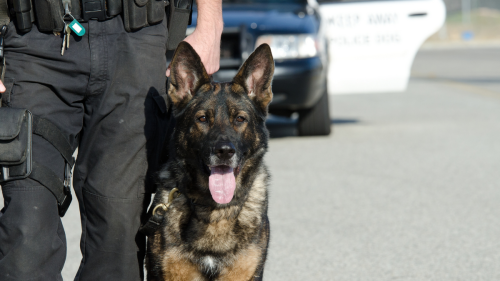By Jason Brady, DBA, MICP, CEMSO
When New Jersey State Police K-9 Kona sustained a traumatic head injury during a 2023 search mission, the clock was against her. There was no formal protocol in place for providing advanced medical treatment or rapid air transport to injured K-9 officers. In that moment, the University Hospital JEMSTAR Medevac Team did what EMS professionals do best: adapt quickly, apply training and find a solution.
Our flight crew flew Kona more than 85 miles to Red Bank Veterinary Hospital, where she received lifesaving neurological care. She made a full recovery and has since returned to duty, proudly serving alongside her handler, now sporting her own pair of protective dog goggles.
Kona’s rescue highlighted a glaring gap in public safety response: while law enforcement K-9s are considered sworn officers and critical partners in missions, their access to emergency medical transport was undefined. From that incident, the K-9 Kona Medevac Program was born.
| STAYING ALERT: What officers need to improve situational awareness
Building a K-9 medevac program
Following Kona’s case, University Hospital EMS partnered with the New Jersey State Police, NJSP Aviation Bureau and Red Bank Veterinary Hospital to design a sustainable program that ensures every NJSP K-9 now has access to lifesaving care and air medical transport.
The program rests on four pillars:
- Veterinary medical direction. Red Bank Veterinary Hospital provides oversight and consultation for in-flight care, mirroring how EMS physicians support paramedics.
- Crew training. Flight nurses and paramedics receive specialized education on canine anatomy, physiology, airway management, trauma and heat-related emergencies.
- Equipment. JEMSTAR aircraft carry dedicated K-9 medical kits, including canine oxygen masks, airway adjuncts, IV/IO supplies, and protective gear such as muzzles and harnesses.
- Protocols. Standard operating procedures clearly outline activation criteria, veterinary involvement, in-flight monitoring and handoff requirements at receiving veterinary facilities.
K-9 medevac: A true collaboration
The K-9 Kona Medevac Program could not exist without collaboration.
- The NJ State Police K-9 Unit defined the operational need and provided access for joint training
- The NJSP Aviation Bureau integrated canine transport into flight operations
- Red Bank Veterinary Hospital committed expertise and around-the-clock consultation
- University Hospital EMS coordinated program design, quality assurance and training
Together, these partners created a system that provides peace of mind to K-9 handlers, reassurance to the law enforcement community and a higher standard of care for the dogs who serve.
Protecting our K-9 partners
K-9 officers are more than working dogs — they are lifesaving partners in public safety. They locate missing persons, detect explosives, track suspects and protect their human counterparts. Yet, until now, many agencies lacked a plan for how to care for them in emergencies.
By establishing clear protocols, medical oversight and dedicated resources, New Jersey is leading the way in ensuring K-9 officers are treated with the same urgency and dignity as their human partners.
The emotional impact cannot be overstated. Handlers know their dogs are family. EMS providers understand that when we protect the entire team — two-legged and four-legged, we uphold the highest standards of care and compassion.
Growing K-9 medevac services
The K-9 Kona Medevac Program is still young, but its framework is designed for growth. We are already exploring ways to expand training to ground EMS crews, integrate veterinary partners into joint exercises and share lessons learned nationally.
Our hope is that other states and agencies will adapt this model. The formula is simple:
- Identify veterinary partners
- Train EMS providers in basic K-9 emergency care
- Equip aircraft and ambulances appropriately
- Establish clear protocols for handoff
Kona’s story began as an emergency, but it has evolved into a statewide commitment. Through collaboration, we now have a system that ensures no K-9 officer is left without a plan for lifesaving care.
Serving our K-9 heroes
The K-9 Kona Medevac Program reflects the very best of what EMS can achieve when faced with a challenge:
- Innovation
- Collaboration
- A refusal to accept “we don’t have a policy” as an answer
It is a promise that every member of the public safety family — human or canine — will receive the care they deserve.
JEMSTAR. New Jersey’s Medevac. Protecting heroes on two legs — and four.



